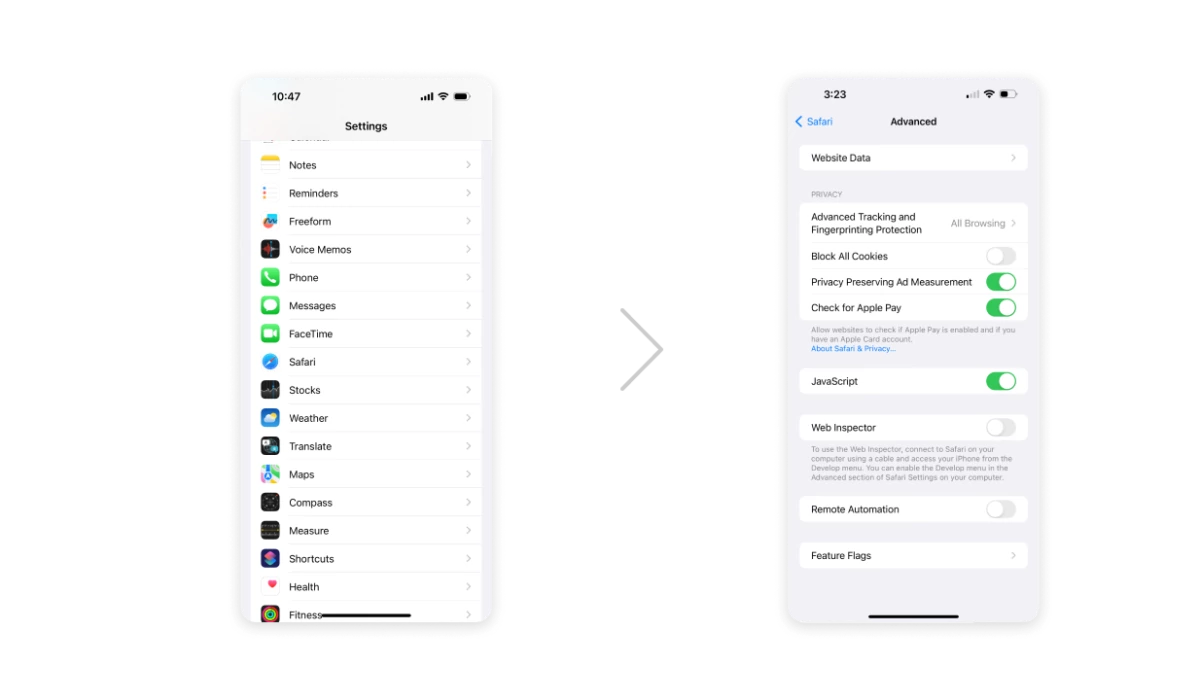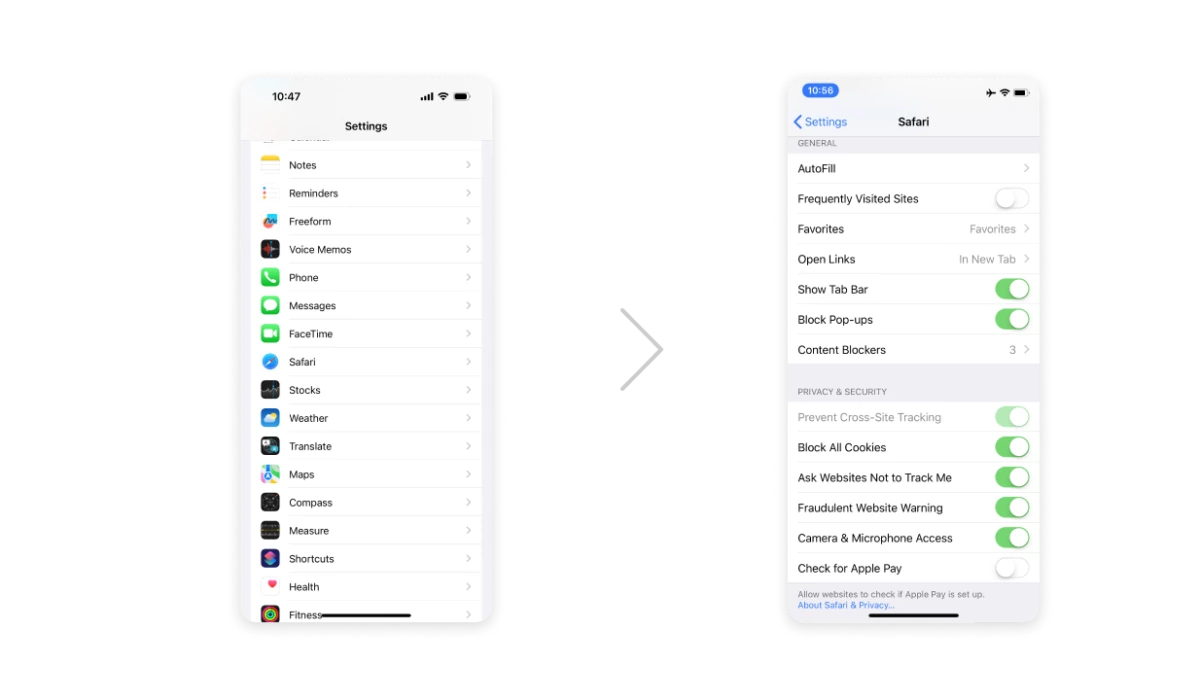How to Stop Redirects on iPhone in Safari Browser
You try opening the website and face this error instead:
| Safari can’t open the page because too many redirects occurred |
The problem of too many redirects on Safari on iPhone is one of the most common. And to save you time from browsing dozens of Apple support pages, we have collected all the methods that will solve the error in this article. Wait no more and read on.
Why does this error appear?
The error “too many redirects” on iPhone can occur for several reasons, and fortunately, it is not caused by your actions:
- Cookies and Website Data Issues: Cookies store information about your browsing sessions, such as login status or preferences. If there’s a problem with these cookies, it can create a loop where the browser keeps trying to reload the page using faulty data, leading to the redirect error.
- Incorrect Website Configuration: Websites use redirects to send visitors to a new page or updated URL. If a website’s settings are wrong, it can cause an endless loop of redirects. For example, Page A redirects to Page B, but then Page B redirects back to Page A.
- Issues with Server Settings: Servers (where websites are hosted) have configuration files that control how they respond to requests. Misconfigurations in these files (like those for Apache or Nginx servers) can accidentally set up a loop where the server repeatedly redirects your request.
- Outdated Cache: Browsers cache (store) information from websites to load pages faster on subsequent visits. If this cached information is outdated or corrupt, it might include old redirect instructions that no longer make sense, causing the browser to get stuck in a loop.
- Ad Networks Redirects: Ad networks often use redirects to track user behavior or serve different ads dynamically. If these redirect sequences are too complex or if there’s a mistake in the redirect chain, it can cause the browser to follow an endless loop of redirects.
- Malicious Ads: Some ads contain malicious code (malvertising) designed to create redirect loops. This can be intentional, to trap users in a loop for click fraud, or accidental due to poor coding. These malicious ads can hijack your browser’s normal behavior, causing the redirect error.
Now, we’ll give you several methods to solve the redirect issue. Don’t hesitate to try all of them.
Method 1: Delete website data
If Safari can’t open a page, too many redirects might occur due to an outdated website cache. Here is how to fix this:
- Open Settings find and tap Safari;
- Scroll down to the bottom edge of the page and tap Advanced => Website data;
- Use the Search field to find the redirecting website’s name. Select the website and swipe it to the left to delete its data. This action deletes all stored data for that site, including caches and cookies. This might log you out of the site or change how it behaves;
- Relaunch Safari and reach the website in question. The problem should be gone.
If the problem persists, repeat these steps. Instead of deleting data for just one site, click Remove All Website Data to clear data for every website you’ve visited in Safari.

Method 2: Enable Cross-Site Tracking
If you really want to visit a website that returns too many redirects, you’ll have to compromise your privacy a bit. But don’t worry, once you fix the problematic site, you can prevent tracking again. This method is especially useful if you need to log in or register in the app, and it redirects you to a web page that can’t be opened.
Here’s how to fix too many redirects on iPhone in Safari settings:
- Open Settings, find and tap Safari;
- Scroll down to the PRIVACY & SECURITY section and toggle off Prevent Cross-Site Tracking;
- Now force close every open app, wait a few seconds, and try reaching the problematic site. If everything is ok, go back into Settings and toggle on Prevent Cross-Site Tracking.

Method 3: Use AdLock

If too many redirects occurred on your iPhone due to poor advertising on a web page, the best solution would be to use an ad blocker. AdLock is an excellent content blocker that ensures a smooth, ad-free browsing experience. AdLock even removes ads before and during YouTube videos, including midrolls. The best part is that it’s free. Yes, you can enjoy ad-free Safari browsing without tracking, online threats, and annoying ads completely free of charge.
Here’s how to stop redirects on iPhone with AdLock:
- Download AdLock from the official App Store and install it on your iPhone or iPad.
- Go to Settings, find Safari, and tap on it.
- Tap on Extensions and toggle on all AdLock switches.
- Launch AdLock and activate the Ad-free web surfing toggle for ad-block. Wait for the filters to download.
These steps will block ads exclusively in Safari. If you want to extend ad-blocking to apps and games on your iPhone:
- Choose a $12 yearly or $3.49 monthly Premium plan after toggling the switch. Remember, one subscription covers multiple apps. Plus, you can enjoy a 7-day trial and get a refund if dissatisfied.
Method 4: Confirm You Are Accessing the Mobile Website, Not the Desktop Site
This is the last resort if nothing helps. Too many HTTP redirects on iPhone might be more common when you’re viewing the desktop version of a website instead of the mobile-optimized version. This issue can arise if you’ve copied a link from a desktop browser and transferred it to your iPhone, perhaps through the messenger app.
What about other browsers on the iPhone?
Too many redirects can occur on browsers other than Safari on iPhone. Browsers like Google Chrome and Mozilla Firefox may also encounter this problem if a website has misconfigured redirects or if there are issues with cookies, cache, or server settings. To fix it, you need to configure browsers’ settings and consider using a paid version of AdLock to prevent the issue from happening again.
For Chrome: Open the browser and click on the three dots in the bottom-right corner=> Settings=> Privacy and security => Clear browsing data => All time => Check the boxes for Cookies and other site data and Cached images and files => Restart Chrome and try accessing the website again.
For Mozilla Firefox: Open Firefox and click on the menu button (three horizontal lines) in the bottom-right corner => Settings => Data Management => Toggle on Cache, Cookies, Offline Web Site Data => Tap Clear Private Data => Restart Mozilla Firefox and try reaching the website again.
Conclusion
When an iPhone has too many redirects, it’s always frustrating yet solvable. Among the issues where you can’t get an adequate solution from the Apple support team, this one is the mildest. Clear out your cookies and cache, turn off any extra browser settings if needed, and ensure the website is set up correctly. Additionally, using an ad blocker for iPhone apps can help you avoid facing the redirect problem again.





